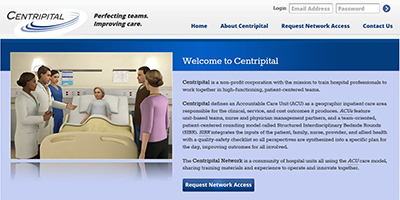ACU-SIBR
Bringing the Team Together: Structured Interdisciplinary Bedside Rounds
In most hospitals, the doctors, nurses, pharmacists, social workers and other allied healthcare professionals that make up each patient's "care team" operate individually. Patients see members of the team at different times with no unified message or collaborative care planning. According to Jason Stein, MD of Emory Healthcare, the asynchronous nature of this care model was the motivation behind his development of structured interdisciplinary bedside rounds, or SIBR.

Jason Stein, MD
In the SIBR care model, every member of the care team visits the patient and family together. As opposed to the traditional model in which physicians have patients in multiple wings of the hospital, the hospital professionals responsible for patients are part of an "accountable care unit," or ACU, which means they share the integrated physical space, patients, workflow, and value outcomes on a single hospital unit. This geographic proximity allows the entire care team to communicate more easily and establish a consistent daily routine for rounding and caring for patients together as a team. Communication within the care team and with the patient and family is now predominantly face-to-face instead of reliant on paging, phones, and notes written into the medical record.
As a result, many different facets of patient care can be discussed simultaneously, and all individuals involved in the patient's care planning can work together. For each patient, SIBR follows a standard communication sequence including a quality-safety checklist. The physician, nurse, and allied health professionals each have a clearly defined role, sequence, and time allotment to share their perspective, including time for the patient and family to ask questions and voice concerns. As a result, hospitalized patients receive care that is much more effective and efficient than what has been typical in modern hospitals.

Stein is formally trained in healthcare quality improvement and has worked in the field of hospital medicine for twelve years. He is the Associate Director for Quality and Director of the Clinical Operations Program for the Division of Hospital Medicine at Emory University School of Medicine. Through his experiences leading and teaching quality improvement locally and nationally, Dr. Stein realized that the solution sets for sequential quality improvement projects typically fail to scale to successive projects. He became inspired to view quality improvement from a design perspective, hypothesizing that the right hospital care model should be able to achieve the outcomes sought by otherwise unrelated individual projects. Stein shifted his focus from conducting quality improvement projects to designing care models, and consequently developed the ACU-SIBR model.
Stein has supported implementation of the ACU-SIBR care model in multiple units at Emory University Hospital, Emory University Hospital Midtown, Emory John's Creek Hospital, as well as hospitals in seven U.S. States and more than 15 hospitals in New South Wales and Victoria, Australia. Both patients and hospital staff have responded very well to the care model, reflecting the joy of working in high functioning teams. At Emory University Hospital, the ACU-SIBR care model has been associated with a 50% decrease in in-hospital mortality in the first year when compared to the previous year, and patient length-of-stay has decreased by 10%. Stein has authored an ACU-SIBR implementation guide which has been licensed to a start-up company, Centripital, which he founded with a mission to train hospital professionals to work in high functioning teams.
"Jason and Centripital have been able to really functionalize the concept of 'team' for a healthcare setting to the benefit of both providers, and patients" says Cliff Michaels assistant director in the Office of Technology Transfer.
Centripital will continue to develop the know-how for the most effective and efficient training and implementation of the ACU-SIBR care model. Furthermore, it will sub-license the know-how to commercial partners dedicated to helping hospitals import and customize the model to meet their needs.
Additional Emory Publications on ACU-SIBR
Emory News Center: Emory Saint Joseph's introduces new model of patient care